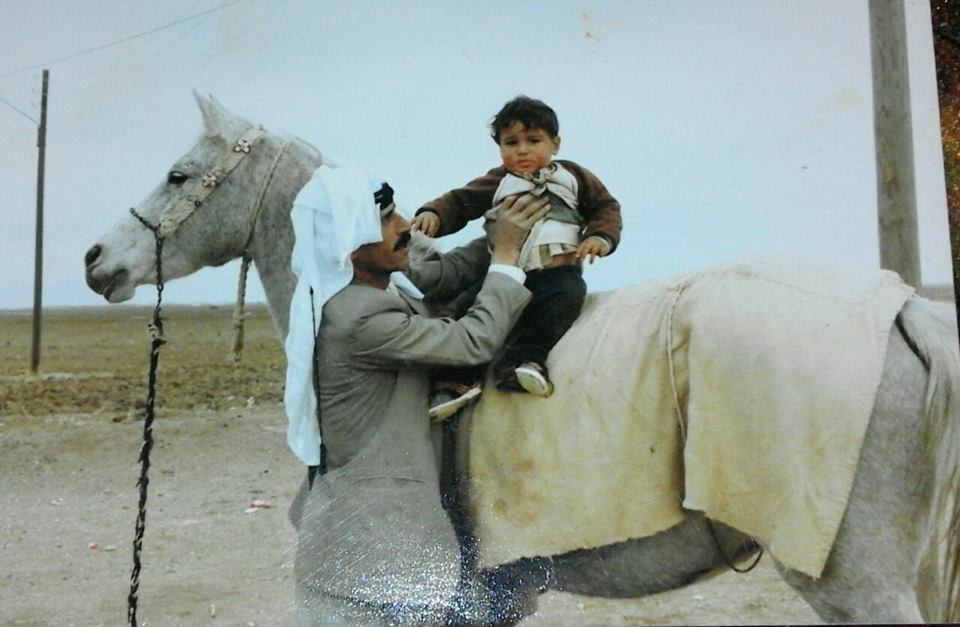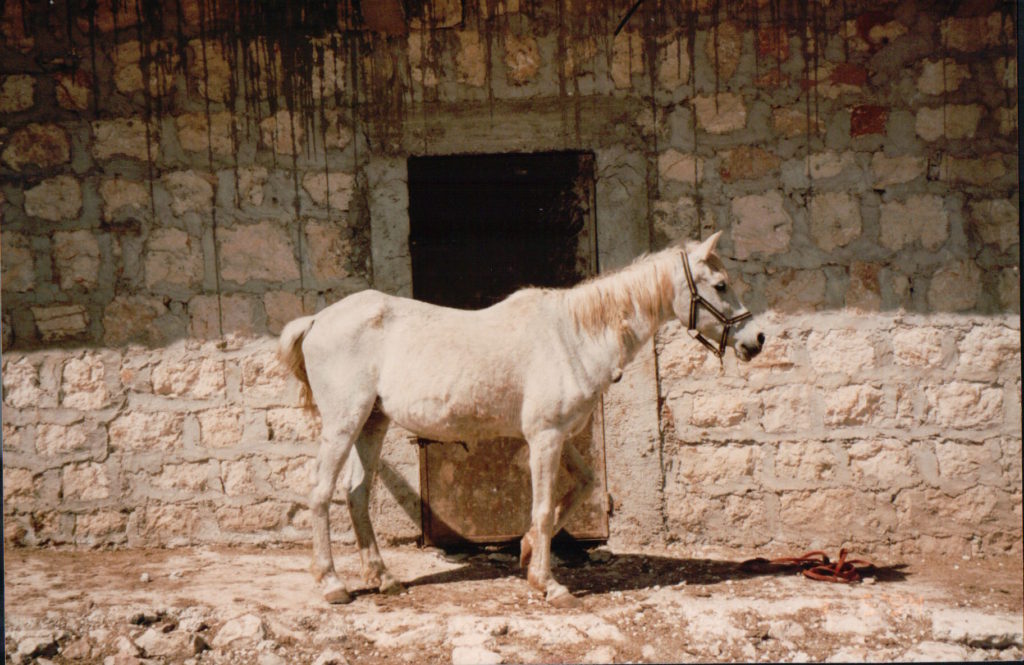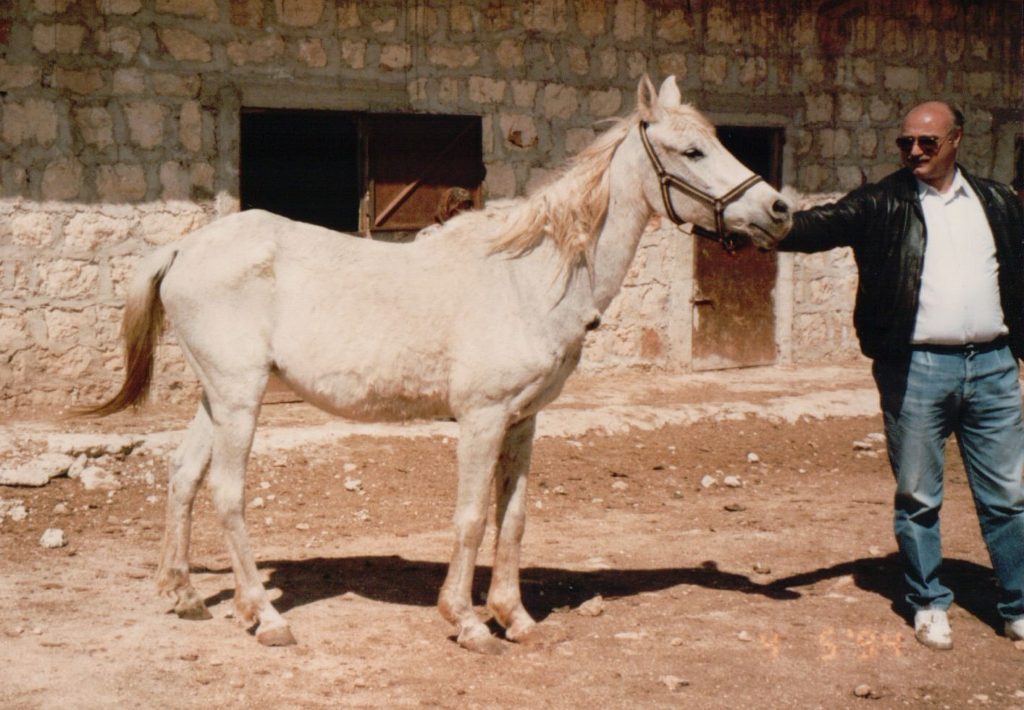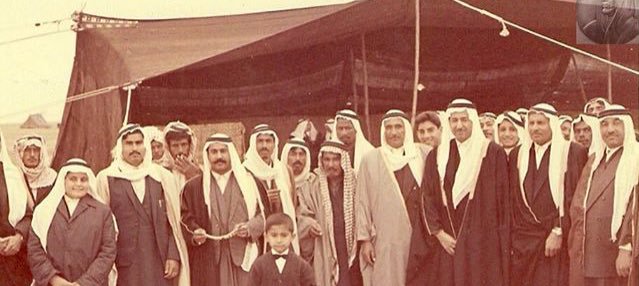The desert-bred Saqlawiyah of Muhammad al-Rhayyil
I spent the morning digging through old photos, which also bring back stories. I like this photo so much. It features a Tai Bedouin horse breeder, Muhammad al-‘Abd al-Sulayman al-Rhayyil, putting one of his toddler sons on his Saqlawiyah mares near Al-Qamishli, North Eastern Syria. The photo belongs to the sons, now grown men in their thirties and fourties. I believe it is from the early 1980s.

The mare is a Saqlawiyah Jadraniyah from the breedeing of al-Rhayyil. He or his father obtained what would have been the granddam of this mare in 1952 from the family of the Shaykh of the Tai, Abd al-Hamid (a.k.a Hamid) al-Talal al-‘Abd al-Rahman. The latter got the line from the family of the owner of the marbat, Hasan al-‘Amud, the Shaykh of the ‘Amud section of the Northern Shammar.
According to ‘Abbas al-Azzawi (in his encyclopedic book “The Tribes of Iraq”, in Arabic), who quotes the Shaykh of the ‘Amarat Bedouins Mahruth ibn Haddhal, the ‘Amud had obtained the prized original mare in war from the Frijah section of the Ruwalah. This piece of information makes this line one of the most authenticated Saqlawi lines in the desert, because the Frijah are the wellspring of the Saqlawi Jadran strain (Jadran/Qadran was from the Frijah).
I believe, without being certain, that the mare with the toddler in the photo above is the same as the old mare I saw and photographed at Radwan Shabareq’s in Aleppo in the mid 1990s (two of my photos below, Radwan holding her). The eyelashes are certainly the same! If it’s not her, then it’s a sister or a daughter. Radwan had leased the mare, which he called Namshah, from al-Rhayyil in extreme old age. He also owned her two grand-daughters. That mare was a daughter of the legendary Saqlawi Marzakani stallion Abu Kitf.


In the 1930s or 1940s, the Bedouins of the area around the Iraqi-Syrian border held a 100 km race at full gallop that has remained in collective memory ever since. A Saqlawiyah mare from the marbat of Hasan al-‘Amud came head to head at the finish — some say a close second — with a Shuwaymah Sabbah mare ridden by Mut’ib ibn Juday’ al-Hayiss al-Farhan al-Jarba. Mut’ib is in one of the men in the photo below, from a Shammar Twitter account.
Incidentally, both the lines of this Saqlawi Jadran of Ibn ‘Amud and the Shuwayman Sabbah of the Jarba currently survive in Europe. Two younger Syrian mares, Rafikat al-Darb, a Shuwaymah Sabbah, and Quokriya (spelling?) Al-Shatane, a Saqlawiyah ibn ‘Amud, are owned by two French ladies. Neither is breeding from them.

I get all the way to the last sentence, and cry out.
I love the muzzle of the younger mare – the dark lipstick, plus the fact that her nostrils are angled upwards, instead of the odd tip-of-the-nose placement seen on some of the main ring horses. The old mare is very elegant, despite her age, whether or not she is the same as the younger mare.
Regarding the Saqlawi Marzakani, that is a substrain I’ve not heard of before – I would love to know more about its origins and connections to the other Saqlawi strains.
She is the same, I checked.
Oh and I fully agree with you on the placement of the nostrils, this is where they should be. Their placement, for instance in the case of Ruminaja Ali:
https://www.selectbreeders.com/articles/ruminaja-ali-foals-born-13yrs-after-stallion-dies
is not ideal, and as you say, looks weird.
On Saqlawi marzaqani, there is a lot to say..
En Avril 2008 avec Jean-Claude Rajot et Louis Bauduin. Nous avons pu examiner la petite fille Amouda (1987) de la grise Namshat (1971) qu’on apercevait à quelques centaines de mètres mais que Mr Mohammad Abd-Al Soliman Al Rayyel n’as pas voulu nous montrer. Amouda était suitée d’une magnifique pouliche. C’est le plus bel élevage que j’ai pu voir en Syrie notamment Amouda: cachet de race, armée dans ses membres, garrot prolongé, épaules et hanches et jarrets larges, rein voussé, Auge large.
En regardant mes notes que j’avais transmise à Abou Jamil notre guide propriétaire de Rafeeqet Al Darb de chez Radwan Chabareq, j’ai vu qu’il y avait également chez Mohammad Abd Al-Soliman Al-Rohaiel il y avait plusieurs descendantes de Namshah la jument Zahouha (2002) suitée d’un mal par Khaldee,la jument Nakh-Wah (2002) par le magnifique Marzouq Al Thanie (accidenté) et suitée par une femelle par Khaldee. De par leurs morphologies et leurs cachets de race cela m’évoquait le tableau des juments du haras de la Rivière dans les années 1840, parmi les deux premiers élevages d’arabe en France en race pure et qui plus est “oriental” avec le haras de Tocqueville à Gueure prés de Dieppe, où figuraient entre autre Furette par Massoud et sa fille Kebira par Mesrur.